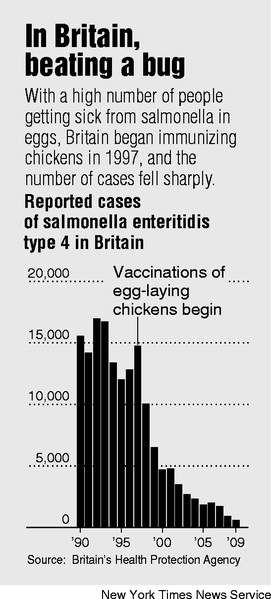Unlike Britain, U.S. shuns salmonella vaccine for hens
Published 5:00 am Wednesday, August 25, 2010

- Bottles of salmonella vaccine are prepared for shipping at the Lohmann Animal Health International facility in Winslow, Maine, on Tuesday. The U.S. does not require chickens to be vaccinated for salmonella, but farmers in Great Britain virtually wiped out the health threat by beginning vaccinations a decade ago.
Faced with a crisis more than a decade ago in which thousands of people were sickened from salmonella in infected eggs, farmers in Britain began vaccinating their hens against the bacteria. That simple but decisive step virtually wiped out the health threat.
But when American regulators created new egg safety rules that went into effect last month, they declared that there was not enough evidence to conclude that vaccinating hens against salmonella would prevent people from getting sick. The Food and Drug Administration decided not to mandate vaccination of hens — a precaution that would cost less than a penny per a dozen eggs.
Now, consumers have been shaken by one of the largest egg recalls ever, involving nearly 550 million eggs from two Iowa producers, after a nationwide outbreak of thousands of cases of salmonella was traced to eggs contaminated with the bacteria.
The FDA has said that if its egg safety rules had gone into effect earlier, the crisis might have been averted. Those rules include regular testing for contamination, cleanliness standards for henhouses and refrigeration requirements, all of which experts say are necessary.
However, many industry experts say the absence of mandatory vaccination greatly weakens the FDA rules, depriving them of a crucial step that could prevent future outbreaks.
Salmonella bacteria is passed from infected hens to the interior of eggs when they are being formed. The salmonella vaccines work both by reducing the number of hens that get infected and by making it more difficult for salmonella bacteria to pass through to the eggs.
“They are the only thing I’m aware of that really controls the problem from the inside out, at the source,” said Ronald Plylar, the former president of a company that developed an early salmonella vaccine.
Many people in the American egg industry say they believe that the current outbreak and recall will tip the balance and force nearly all producers in the United States to begin vaccinating hens to reassure consumers.
The FDA said it considered mandatory vaccination very seriously. “We didn’t believe that, based on the data we had, there was sufficient scientific evidence for us to require it,” said Dr. Nega Beru, director of the agency’s Office of Food Safety.
However, Beru says that the new rules encourage producers to vaccinate if they think it will help fight salmonella.
Another FDA food safety official, Nancy Bufano, said that despite the success of vaccination in Britain, the agency thought that because the vaccines used in the two countries were not identical, it made comparisons difficult.
Vaccine company executives, however, said the differences were minor and the drugs used in both countries were equally effective.
The FDA has estimated that it would cost farmers about 14 cents a bird to vaccinate, or about $31 million to cover hens at all the large farms in the country. But vaccine company executives said the cost can be just a few cents a bird, depending on the type of vaccine and how many doses are given. A single bird can lay about 270 eggs in its lifetime.
After the current outbreak, “many producers that were trying to decide whether or not to vaccinate will now vaccinate,” said David Zacek, the chief executive of Lohmann Animal Health International, one of three companies that produce the vaccines in the United States.
Vaccination began
The two companies involved in the recall, Wright County Egg and Hillandale Farms, said that they began introducing vaccinated birds to their Iowa operations last year. But the companies have seven separate facilities in Iowa with a total of about 7 million birds, and it can take up to a year and a half to replace all the hens on a large farm.
The companies would not say how many of their birds had been vaccinated when the outbreak started this spring. Wright County said that currently about three-quarters of its birds have been vaccinated and Hillandale said it has now vaccinated about 80 percent.
Industry experts said that in a typical facility, eggs from different laying barns are commingled when they are sorted and packed, so it is possible that eggs from vaccinated and unvaccinated hens can be shipped out together.
“That’s how a farm can be moving in the right direction but still only be partially protected,” said Dr. George Boggan, technical service veterinarian for CEVA, the vaccine company that works with Wright County Egg.
New egg rules
The FDA began working on its new egg rules more than a decade ago, and a review of agency documents suggests that officials formed a negative opinion about the effectiveness of vaccines early on. That opinion failed to change as time passed and evidence mounted that vaccines significantly reduced the occurrence of salmonella.
Many small-scale trials show vaccines are effective. But the FDA said that only large-scale field trials could prove that a vaccine would work in the real world of commercial henhouses.
One such trial cited by FDA officials was a 1999 Pennsylvania study that found little difference in salmonella levels between some vaccinated flocks and an unvaccinated control group. “Currently there is no vaccine that has been shown to be efficacious in the field,” the agency wrote in a public summary of its views last year.
However, Dr. Sherrill Davison, the lead researcher on that 1999 study, said that the FDA’s assessment did not reflect advances made since then.
“That data was very preliminary data that used vaccine technology from the beginning of these programs, and that technology has changed and our understanding of how to administer them has changed,” she said.






